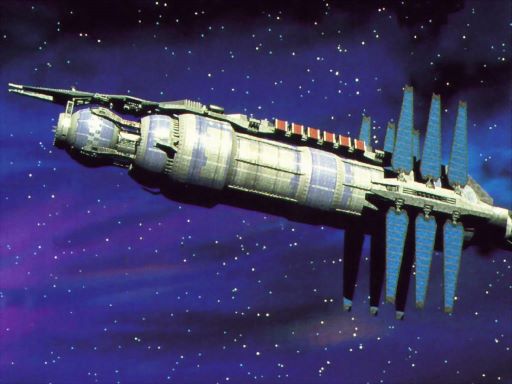 |  | ||||
Were individual systems not part of the larger UGC, the stations would be embassies; In fact, in systems that are not yet part of the UGC, they are embassies. Since the systems have their own Governors, the UGC assigns an outsider, the Councilor Executor (one who carries out the administration of a system, not to be confused with 'executioner,' an officer of the court who carries out capital punishment sentences). The Council Executor is appointed from outside the system, with the duties of ensuring the UGC's interests are protected, politically, economically, and militrily. They have the authority to call up a full battlefleet if needed, as well as overrule a Governor and place the system under Council Law (not quite martial law, but very very close). The Babylon-Class space Stations were developed to house these people, plus the materials they would need in the event that the UGC's interests in the system were threatened. They are actually built at various Neotech Factories around the galaxies (often starting with NUPETIET VERGNITZS-Class by scrapping it out, most coming from the Forgotten Fleet). Co-housed in these stations are SPAES cutters, SAR, and Port Security units, Customs Houses, and a massive trading center; Over 100 billioncredit worth in deals are made any given day here. Add to this educational exchanges of every sort, and very often the application of some new system (or, on occasion, even full empires, such as the The Kobolese Confederation) to join the UGC. The stations do posses space fold drives, just like those used on inter-galactic vsls (such as the Spacy and Patrol's ships and others owned by the UGC itself), but these are kept on standby; They are typically one-way systems, to get the station to her final home. The Babylon-Class are critical for another, curious, purpose- They are where the average citizens can most easily reach the UGC as a whole, and thus apply for relief from matters of interest to the system. That means when a system Governor gets out of hand (such as Admiral DAALA'S brutal maltreatment of the Fehranians), the people have somewhere to go. Though in theory there is always a consulate, mission, or other official facility on-planet, very often the UGC has found those who man these offices have their own agenda, and ignore the pleas for help- Or even reWard the Governors for what they've done (such as happened on FBX 21555320). Additionally, the stations have a series of platforms all their own, outside the ownership of the Spacy, Patrol, or any other governmental agency; These are owned by the station itself, at the disposal of her Commanding Officer and System Executor, both of whom answer to the council, not the chairman Joint chiefs Of Staff, Secretary of Defense, Secretary of State, or anyone else. (In point of fact, they answer to the Chairman directly; they can be called before the full Council or either Compartment and must answer their questions, but can not be punished by them.) They are: Eagle-Class Freighter (usually about 50 of these) Starfury Fighter (around 50) WHITE STAR-Class Corvette (3 or 4) Of these, the Eagle-Class Freighters are generally agreed to be the most important; After all, no trade, no station- They could never afford to support themselves. Ship Type: Long Duration Space Habitation/Office Vessel Crew (not including connected ships): 1.2 million total Militry Crew: 2,2000 Civilian Crew/Scientists: 25,500 Police/Civil Defense: 15,000 MDC By Location: | |||||
| * Hull Small Airlocks/Access Hatches (200) Main Airlock Outer Hull (per 40ft area) Interior walls (per 20ft) External Engineering/Sensor Spokes (8) Lower Sensor Spoke | 60,000 250 each 1,000 120 40 2,000 each 1,200 | Exterior Central Line Pods (2) Exterior Rear Pods (2) Connection Joint/Engineering Section **Main Engines/Power Plant (2) ** Auxiliary Engines (4) *** Pin Point Barriers (4) | 6,750 each 10,000 each 8,500 12,500 each 6,000 each 5,000 each | ||
| Notes: * Depleting the MDC of the hull will essentially destroy the vessel. All internal systems will shut down, including life support and internal gravity. The colony ship itself will be an unsalvageable floating wreck, and any surviving colonists must be rescued quickly or will die from asphyxiation as the remaining atmosphere drains into space. ** Depleting the MDC of the main engines will force the ship to rely on its auxiliary engines. Depleting the MDC of the main engines AND auxiliary engines will leave the colony ship adrift in space. If in an atmosphere, the colony ship will crash (destruction of the main engines will render the antigravity system useless due to loss of power). *** The Pinpoint Barriers regenerate at a rate of 1,250 MD per second (2,500 MD per melee round). If destroyed, a barrier will completely regenerate within four seconds (2 melee rounds). Speed and Statistical Data: | |||||
| Speed (sublight): 0.16 speed of light (25,600 miles per second). Speed (Auxiliary Drives): Mach 3. Space Fold: Equipped. Planet Bound: Designed to land in a planetary ocean when necessary but not designed to maneuver in an atmosphere. The Einstein-Class is NOT designed to land on the ground. If it does so the landing will inflict 3D6 times 1000 MD damage to the main body of the spacecraft (the lower sensor spoke will be automatically destroyed). Maximum Range: Unlimited (estimated 30 year life span). Hull Length: 4,101 feet 1/2 inch (XXm). | Hull Clearance: 4,921 feet 04 inch (XXm). Length (connector/engineering section): 215 m. Weight: Approximately 5.5 billion tons standard. Power System: ORTEC/General Galaxy Main Reactor. Fold System: ORTEC/Shinnakasu/General Galaxy Advanced Fold System Cluster. Sublight Drive: ORTEC/Centinel Impulse Drive Cluster. Gravity Control System: Internal. Auxiliary Engine: Shinnakasu/Shinsei Industries/Agar Nuclear Pulse Rocket Motor Cluster. | ||||
Weapons Systems: | |||||
| 1. Pinpoint Barrier Defense System: Originally developed by researchers onboard the SDF-01 MACROSS during the First Robotech War, the Pinpoint Barrier System is a standard defense system on board all UN Spacy starships and colony vessels, including the Einstein colony ships. The system generates four small disc-shaped force fields that can be positioned anywhere along the ship to deflect missiles, energy beams or projectiles. Each pinpoint barrier is about 200 ft (61 m) in length and can absorb up to 5,000 MD in damage, which then regenerates within four seconds (2 melee rounds). The barriers can also be layered on top of each other to generate a field which provides 20,000 MDC and can even deflect heavy particle beams (usually). The four barriers are controlled by operators in the command tower of the carrier. These operators are instructed to defend (1) any breaks or weaknesses in the main hull, (2) the engineering section/battle carrier docking section, and (3) the main and auxiliary engines, in that order. The operators primarily concentrate on defending the ship against larger spacecraft and leave defense against attacking Mecha to the VF pilots from the battle carrier. Purpose: Defense (the pinpoint barrier system cannot be used as a weapon). Range: Up to 300 feet (91.5 m) from the surface of the vessel. MDC: Can sustain up to 5,000 MD per round. Regenerates at a rate of 2,500 MD per melee round. Radius: 200 ft (61 m). Attacks Per Melee: Can move from one end of the vessel to the other in less than a single round. Trained operators can attempt to block attacks up to 8 times per melee (counts as a parry) and are at +7 to block. Untrained characters can parry up to their number of hand-to-hand attacks with their normal parry bonuses only. Payload: Nearly inexhaustible. Will work as long as system is functional (see below) and engines are intact. If main engines are destroyed, the barrier will loose power and not function. Note: If all four barriers are grouped in a single spot they can deflect a heavy particle beam attack, such as the one generated by the Macross Cannon and T'sentraedi command Warships. However, the beam will completely destroy all four barriers and put incredible strain on the pinpoint barrier system, to the point where it may short out. After deflecting an energy beam, roll percentile dice on the table below to determine additional effects/damage. 01-15: Lucked out, system will be operational in 1D6 hours. 16-30: Minor damage, system will require 4D6 hours to repair. 31-45: Major damage, system will require 2D6 times 10 hours to repair (yes, DAYS of work). 46-60: Completely destroyed! System can be rebuilt, but will require new parts and 2D6 DAYS of work to replace. 61-75: Major damage, system will require 2D6 times 10 hours to repair. 76-90: Minor damage, system will require 4D6 hours to repair. 91-95: Lucked out, system will be operational in 1D6 hours. 96-00: It's a miracle! Trivial damage only, system will be operational again in only 4D6 melee rounds! | 2. Automated Missile Battery (02): 02 of these batteries are on each vessel, on dorsal and one ventral. Missile Type: Any MRM or LRM Purpose: Anti-Ship Defense. MD and Range: Varies by type used. Rate of Fire: Twice per melee. Payload: Up to 1,000. 3. Defensive Laser Batteries (20): Each vessel has 20 defensive laser batteries for anti-missile and meteorite defense. MD: 5D6 per blast. Rate of Fire: Per gunners attacks per melee plus bonuses (generally 4 or 5 per melee). Range: 500 feet. Payload: Unlimited. 4. Ships, Fighters, Power Armor, and Robots: The various landing bays of the President's Point-Class have enough room and resources to adequately support up to 200 squadrons of VFs, hundreds of shuttles, and even a dozen or so full NUPETIET VERGNITZS-Class Fleet Command Ship internally; However, the typical compliment, based on President's Point herself is a couple squadrons of VT's, 'several' shuttles, and a couple of frigates at any given time. Additionally, the anchor whip can hold up to 2,000 standard warships. | ||||
| Features: | |||||
|
| ||||
| |||||
